Apr 12, 2022 | Video Reviews
with Elaine Pinderhughes, interviewed by Monica McGoldrick
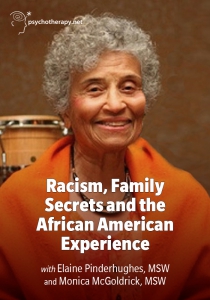 In the African American community, there is a theme of pain and hurt that is often hidden behind family secrets. These family secrets are deeply rooted in the African American experience of slavery and racism that is carried throughout generations. In her 35-minute interview with Monica McGoldrick, MA, LCSW, PhD (honorary), Elaine Pinderhughes, MSW, provides a comprehensive and in-depth narrative about her family heritage, supported by 30 years of research on her family’s genealogy. After the death of her father in 1976 and inspired by Alex Haley’s book entitled Roots, Pinderhughes set out to explore her own family’s roots. This video provides viewers with a glimpse into Pinderhughes’s family’s history, their secrets, and the truth that she discovered.
In the African American community, there is a theme of pain and hurt that is often hidden behind family secrets. These family secrets are deeply rooted in the African American experience of slavery and racism that is carried throughout generations. In her 35-minute interview with Monica McGoldrick, MA, LCSW, PhD (honorary), Elaine Pinderhughes, MSW, provides a comprehensive and in-depth narrative about her family heritage, supported by 30 years of research on her family’s genealogy. After the death of her father in 1976 and inspired by Alex Haley’s book entitled Roots, Pinderhughes set out to explore her own family’s roots. This video provides viewers with a glimpse into Pinderhughes’s family’s history, their secrets, and the truth that she discovered.
A strength in this video was the consistent use of a genogram that highlighted Pinderhughes’s family tree. Genograms may serve as useful tools for counselors working with African American clients and for gathering family history information during the assessment phase. On the genogram, her paternal and maternal family are identified. Pinderhughes provides a brief summary of her paternal family’s education and accomplishments, and she describes the type of community that her father grew up in; however, because of the lack of information available because of slavery, Pinderhughes was unable to research her paternal family prior to 1870.
Pinderhughes then discusses her maternal family history. She explains that her mother died when she was 16 years old, and during the video, Pinderhughes recounts her experience of growing up with a mother whom she describes as an extremely fair-skinned Black woman, who was often mistaken for White by both Black and White people. Pinderhughes reports that her mother never spoke about her biological father, and she also discusses the challenges that she experienced when attempting to obtain information about her mother’s paternity from her maternal relatives. Pinderhughes’s research revealed a shocking family secret: Her mother’s father was a White sheriff from her mother’s town, and she believes that her mother was born as a result of rape. She identifies other mixed-race maternal relatives on her genogram, who she also believes were born as a result of rape. The information provided in this part of the video reveals the hidden historical truth about the sexual abuse of Black women. Because of the pain associated with this knowledge, this information also provides insight into why Pinderhughes’s family chose to hide this secret for so long.
Within the video, Pinderhughes also broaches the salient topic of skin color, which remains a sensitive subject among African Americans. Pinderhughes is very transparent in providing the viewer with several poignant examples of her own experiences with skin color. In one example, she describes feeling like she did not “belong” to her mother, because her mother looked White and Pinderhughes did not. She then goes on to discuss an incident where she was lectured by her father for using the term dark-skinned when describing another girl. This causes her to reflect on the challenges that she experienced with having a mother who looked White and a father who looked African, and not being able to speak about skin color within her household. A final example that she provides is an internal conflict that she felt toward her paternal aunt, who came to care for her after her mother’s death, and whom she characterizes as a loving individual, yet one that looked similar to “Aunt Jemima” in her perspective. She discussed feeling ashamed of her aunt’s appearance and the dichotomy of having a mother who looked White and an aunt who looked the opposite. She discussed coming to terms with those feelings of shame around 4 months prior to this video recording and “weeping” because of it.
Elaine Pinderhughes’s transparency is both courageous and inspiring, and her family’s narrative is reflective of the African American experience. The secrets that are maintained within these families as a result of racism have the ability to do harm to each generation. Counselors-in-training and professional counselors will benefit from watching this video to gain an understanding about the historical layers of pain often carried by African Americans. The Multicultural and Social Justice Counseling Competencies encourage counselors to explore the client’s worldview as well as obtain knowledge about the client’s history (Ratts et al., 2016). This video would be valuable to utilize in courses for both multicultural counseling and marriage and family counseling.
McGoldrick, M. (Host), & Pinderhughes, E. (2021). Racism, family secrets and the African American experience [Video]. Psychotherapy.net. https://www.psychotherapy.net/video/mcgoldrick-racism-family-secrets
Reviewed by: Lori Nixon Bethea, PhD, NCC, ACS, LPC
The Professional Counselor
tpcjournal.nbcc.org
References
Ratts, M. J., Singh, A. A., Nassar‐McMillan, S., Butler, S. K., & McCullough, J. R. (2016). Multicultural and Social Justice Counseling Competencies: Guidelines for the counseling profession. Journal of Multicultural Counseling and Development, 44(1), 28–48. https://doi.org/10.1002/jmcd.12035
Jul 27, 2021 | Video Reviews
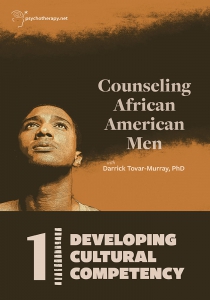
The need for multiculturally competent school counselors is more apparent in light of the racial injustice occurring in 2020 and the Black Lives Matter movement (BLM). Black men experience systemic oppression, racism, and racial disparities that result in negative emotional side effects (Carter, 2007). In coordination with Dr. Darrick Tovar-Murray of DePaul University, Psychotherapy.net has developed this timely continuing education video series course to help counselors and counselors-in-training effectively work with African American men. This video series provides a comprehensive overview of issues that impact and shape the world view of African American men, such as racism, microaggressions, identity issues, collective and intergenerational trauma, and mistrust of professionals.
Dr. Tovar-Murray demonstrates the role of the therapist during counseling sessions to help viewers understand how to use culturally responsive counseling skills to broach and explore experiences that shape African American men in the United States. One strength of the series is the counseling sessions, which include real live sessions with three African American men and discussion both during and after each session to provide clarity and insight to the viewers. The dialog between Dr. Tovar-Murray and Psychotherapy.net founder and CEO Dr. Victor Yalom provides a form of debriefing and deeper discussion about the counseling scenes. Viewers can see the progression of sessions to gain a comprehensive understanding of how treatment with African American men would flow. Another strength of the series is the ability to identify and address the challenges that African American men face through an empathetic lens that guides the therapeutic process. Dr. Tovar-Murray does an excellent job weaving in the many intersecting identities that African American men may embrace. There are three volumes in the series that focus specifically on intersecting identities and the range of emotions attached to being an African American man.
Counselors will benefit from the combination of live sessions with commentary and the extensive accompanying resources, including a transcript of each session, role play exercises, and handouts on topical related issues such as microaggressions and code-switching. Dr. Tovar-Murray provides skill-building exercises and discussion questions to enhance cultural competency and the ability to create safe spaces for African American male clients. All of the virtual and written materials work in tandem to allow viewers the opportunity to practice their skills and debrief each activity. This three-volume series and its accompanying resources would be beneficial for counselor educators to integrate into their training of counseling students learning counseling skills and building self-efficacy as culturally competent counselors. Counselor educators can integrate the videos and the exercises with students to provide culturally relevant role-plays and increase dialogue and discussion around each skill.
The series illuminates the need for cultural competence that aligns with the Multicultural Social Justice Counseling Competencies (MSJCC, Ratts et al., 2016). Understanding and recognizing the oppressive systems that impact African American men is fundamental to a social justice orientation. The sessions that address racism provide an opportunity for counselors to learn through observation and increase awareness as opposed to placing the work on African American clients to educate the counselor. Viewers may be surprised to learn the levels of conflict and confusion that are addressed in topics such as “Walking Around in a Black Body,” “The Good Enough Self,” “Protectors and Providers,” and “Feeling Lost.” Dr. Tovar-Murray moves beyond common stereotypes of African Americans and moves into deeper unseen and lesser-known issues that African Americans face.
One minor limitation of this video series is the lack of concentration around the topic of homosexuality among African American men. Viewers would benefit from a deeper understanding of the stigma in the African American community that individuals in the LGBTQ community carry and how it adversely affects their mental health. Overall, there are many benefits to viewing the series Counseling African American Men. Viewers will walk away with a deeper understanding of how to treat and sit with African American male clients in a safe and respectful manner. This video series is highly recommended for counselors, counselors-in-training, and counselor educators.
Psychotherapy.net. (Producer). (2021). Counseling African American men, Volume 1: Developing cultural competency. (Available on video streaming from https://academy.psychotherapy.net/store/bCuqW5vo)
Reviewed by: Jan Gay, NCC, LICSW, Doctoral Candidate, University of Florida
The Professional Counselor
tpcjournal.nbcc.org
References
Carter, R. T. (2007). Racism and psychological and emotional injury: Recognizing and assessing race-based traumatic stress. The Counseling Psychologist, 35(1), 13–105. https://doi.org/10.1177/0011000006292033
Ratts, M. J., Singh, A. A., Nassar‐McMillan, S., Butler, S. K., & McCullough, J. R. (2016). Multicultural and Social Justice Counseling Competencies: Guidelines for the counseling profession. Journal of Multicultural Counseling and Development, 44(1), 28–48. https://doi.org/10.1002/jmcd.12035
Oct 15, 2015 | Video Reviews
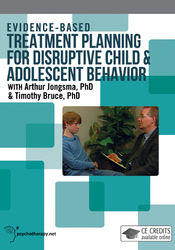 Psychotherapy.net continues to expand its library with additional videos and materials. In reviewing their streaming video on Evidence-Based Treatment Planning for Disruptive Child and Adolescent Behavior, I found the video to be comprehensive and informative. Drs. Timothy Bruce and Arthur Jongsma first focus on explaining the various definitions of behavioral disorders and their related literature. The focus of the video is on the disruptive behavior of the oppositional and conduct type. The viewer is also reminded that many disruptive behaviors can be included in a variety of disorders such as ADHD and ODD. Dr. Bruce then discusses a brief history of the movement to solidify empirically supported treatments (ESTs). One strong goal of the video, which is done well, is to “demonstrat[e] how a treatment plan can be empirically informed by incorporating goals, objectives, and treatment interventions that are consistent with evidence-based practices.” The first half of the hour-long video is dedicated to the education of counselors, and includes citing additional resources and literature that have had an impact on our understanding of counseling regarding disruptive behaviors. The authors also discuss the appropriate use of role modeling, school–counselor–parent interactions, and conflict management techniques. This comprehensive review of resources is given in combination with slide graphics, which highlight the main points to help the viewer gain a strong understanding of the material.
Psychotherapy.net continues to expand its library with additional videos and materials. In reviewing their streaming video on Evidence-Based Treatment Planning for Disruptive Child and Adolescent Behavior, I found the video to be comprehensive and informative. Drs. Timothy Bruce and Arthur Jongsma first focus on explaining the various definitions of behavioral disorders and their related literature. The focus of the video is on the disruptive behavior of the oppositional and conduct type. The viewer is also reminded that many disruptive behaviors can be included in a variety of disorders such as ADHD and ODD. Dr. Bruce then discusses a brief history of the movement to solidify empirically supported treatments (ESTs). One strong goal of the video, which is done well, is to “demonstrat[e] how a treatment plan can be empirically informed by incorporating goals, objectives, and treatment interventions that are consistent with evidence-based practices.” The first half of the hour-long video is dedicated to the education of counselors, and includes citing additional resources and literature that have had an impact on our understanding of counseling regarding disruptive behaviors. The authors also discuss the appropriate use of role modeling, school–counselor–parent interactions, and conflict management techniques. This comprehensive review of resources is given in combination with slide graphics, which highlight the main points to help the viewer gain a strong understanding of the material.
There are a number of clips that model how a counselor would work with parents, as well as with a teenage male, and which highlight how situations can be de-escalated while dealing with the negative behaviors in a positive manner. Techniques are first processed between the counselors and then role modeled through counseling sessions, either with the parents or the child. Following the role modeling sessions the counselors revisit the learning objectives for the section and discuss how they were illustrated through the role modeling. While some of the role-plays seem a little bit scripted, the material is presented in a realistic fashion so that the viewer can see a strong example of how theory, techniques, and practice combine to help clients make positive changes.
The program is well produced with a smooth flow between instruction and demonstration. It is in a video format that is visually clear with good sound, which is appropriate for viewing by an individual or for use with an entire class. One strength of the program is that the video is presented with a complete script, with the added capability of clicking on a word in the script and starting the video at the correlating spot. This capability allows for easy review and navigation throughout the video.
Overall, I would recommend this video as an introduction for beginning counselors-in-training or for professionals who want to review their understanding in this area. Online education has learned that hour-long videos are not the best for comprehension, yet with the Psychotherapy.net system a person can easily return to view the material in smaller sections. The use of these videos as a learning tool is strongly recommended and technology has now allowed us to access these materials easily and at a time of our choosing.
John Wiley & Sons, Inc. (Producer). (2011). Evidence-Based
Treatment Planning for Disruptive Child and Adolescent Behavior. (Available in video streaming fromhttps://www.psychotherapy.net/video/evidence-based-treatment-planning-child-behavior-problems)
Available in streaming format as part of video subscription at www.psychotherapy.net/subscriptions.
Reviewed by: Dr. Matthew Mims, NCC, University of Nebraska at Kearney.
The Professional Counselor
https://tpcjournal.nbcc.org/
Aug 14, 2015 | Video Reviews
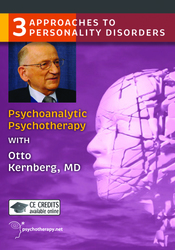 This video presents a close exploration of three psychotherapy sessions between Dr. Otto Kernberg and a mock client with a personality disorder, with commentary and exploration of important issues facilitated by Victor Yalom. The premise and definition of personality disorders is established to set the tone for the psychotherapist’s focus toward the client’s motivations, distortions in close relationships and view of the self within those relationships through an approach called Transference-Focused Therapy.
This video presents a close exploration of three psychotherapy sessions between Dr. Otto Kernberg and a mock client with a personality disorder, with commentary and exploration of important issues facilitated by Victor Yalom. The premise and definition of personality disorders is established to set the tone for the psychotherapist’s focus toward the client’s motivations, distortions in close relationships and view of the self within those relationships through an approach called Transference-Focused Therapy.
The video explores the projections that are driven by such clients’ recurrent fears of being traumatized and provides a clear picture of the manner in which those with identity diffusion struggle to hold a balanced perspective. In these cases, emotion overwhelms them, creating the split view of the self or others as either completely idealized or utterly negative. Focusing on the interpersonal experience of the here and now, the conscious meanings are illuminated through an intensive approach to exploring the interpersonal experience through structural interviewing. The interview, as Victor Yalom points out, moves from a traditional interview toward examination of the interpersonal exchange between the client and the therapist.
The interview process exemplifies an exploration of symptoms, personality, and normal or diffused identity, then reality testing to draw out the fullness of the interaction transference and exploration. Dr. Kernberg illuminates the concept of identity diffusion. Continued discrepancy exploration uncovers the client’s levels of paranoia, suspicion, anger and controlling behavior as this video presents a client who seeks to protect himself from fear of further discomfort or rejection. By interpreting the client’s difficulty with reality openly, a counselor can determine the level of reality acceptance versus the presence of paranoia toward others. The video later demonstrates how to move the interview toward exploring how the client may begin to understand the transference between client and counselor.
The video provides effective commentary by Dr. Kernberg and a continued dialog between Victor Yalom and Dr. Kernberg throughout the mock sessions to emphasize his focus and methods. Dr. Kernberg is respectful, honest and direct with his client while also pointing to the discrepancies he experiences. The video moves through three sessions to show the client’s further exploration of his areas of denial along with his progress toward integrating his inner concept of self.
One limitation of the video is that the first session is lengthy and the second is quite short, which may leave the learner wondering how to structure typical 50-minute sessions with these clients. There are times when the diagnosis is unclear as to whether the client is showing borderline personality disorder or being a borderline patient, which can be confusing to those learning to diagnose clients. Reference to the DSM-5 would be helpful to clarify the diagnosis and the symptoms displayed by the client.
Strengths of this video include the demonstration of continuing assessment if the client presents a new issue, such as potential substance abuse, while maintaining the continued focus on transference. Dr. Kernberg is artful in exemplifying an approach that remains open and honest but neutral in tone, whether the client feels willing to share more information or seeks to control the topic or shift the focus from the most important areas of assessment or counseling. By appealing to the trustful part of the client’s personality, Dr. Kernberg skillfully shows how to draw out this side of the client in order to help gain commitment to the treatment process. The potential for overcoming the problem of distrust and suspicion is modeled to show therapists how to appeal to the part of the client that does trust in order to create more balance in personal responses toward others.
Finally, this video reminds counselors of ways to engage in the therapeutic process through a grounded response to clients, trained awareness of client unconscious projections, and their own well-developed self-awareness in order to manage counter-transference. This video successfully explores the issues vital to understanding the therapeutic relationship through a psychodynamic and psychoanalytic process that helps clients to reconcile polarities by achieving a more integrated view of others. With a video scrolling script format that is easy to understand and follow, counselors can learn effective methods for addressing challenging client issues.
Psychotherapy.net (Producer). (2013). Psychoanalytic psychotherapy with Otto Kernberg, MD. (Available in DVD and video streaming from http://www.psychotherapy.net/video/psychoanalytic-psychotherapy-otto-kernberg)
Available in DVD and streaming format as part of video subscription at www.psychotherapy.net/subscriptions.
Reviewed by: Adele Logan O’Keefe, Walden University, Minneapolis, MN.
The Professional Counselor
https://tpcjournal.nbcc.org/
Jun 22, 2015 | Video Reviews
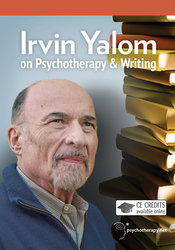 The video Irvin Yalom on Psychotherapy and Writing offers viewers insight into the work of Irvin Yalom through a recorded interview and a question-and-answer session. The interview unfolds around the intersection of Yalom’s work as a psychiatrist and a writer. It is loosely organized into six topics, a format that allows for viewing in a classroom setting in very brief segments, or as a whole in approximately 1 hour. The six sections are titled as follows: “From Psychiatrist to Writer,” “A Novel Method of Teaching,” “The Spinoza Problem,” “Group and Existential Psychotherapy,” “The Power of the Therapeutic Relationship,” and “Q & A.”
The video Irvin Yalom on Psychotherapy and Writing offers viewers insight into the work of Irvin Yalom through a recorded interview and a question-and-answer session. The interview unfolds around the intersection of Yalom’s work as a psychiatrist and a writer. It is loosely organized into six topics, a format that allows for viewing in a classroom setting in very brief segments, or as a whole in approximately 1 hour. The six sections are titled as follows: “From Psychiatrist to Writer,” “A Novel Method of Teaching,” “The Spinoza Problem,” “Group and Existential Psychotherapy,” “The Power of the Therapeutic Relationship,” and “Q & A.”
The interview is conducted by Orah Krug, one of Yalom’s students, and serves as a platform for Yalom’s story, which is intrinsically connected to the story of existential therapy. Yalom recounts his late discovery of writing as an occupational option, due to his pragmatic approach to career choice as the son of an immigrant. He goes on to describe how his curiosity about therapists’ and clients’ experiences; his reading and reflection on history, psychotherapy, philosophy and the evil of the Holocaust; and his practice with and training of residents have all contributed to his motivation to write both fictional and educational texts. The organic and inextricable connection between Yalom’s narrative, practice and writing is vivid in his account; and he discloses that his “secret audience,” even in his fiction, is the psychotherapy student.
For example, in speaking to his inspirations for The Spinoza Problem, his fascination with the man—whom he describes “as the greatest rebel in history” for challenging the veracity of religion—reveals his curiosity and willingness to take risks to explore the depths of the human experience. In fact, his classic works, Existential Psychotherapy and The Theory and Practice of Group Psychotherapy, represent not only his avid love of reading, but also his willingness to explore new territories in theory and practice as he experiences limits or observes effective interventions. His account is forthright, humorous at times, and refreshing in its candor as he cites intuition as a guide for his theory and practice.
These brief vignettes are an optimal introduction for students of counseling who are studying the helping relationship, counseling theory or group therapy, as well as anyone seeking to understand the evolution of thought and practice in the field. Undoubtedly the most powerful segment of the video for students comes when Krug asks Yalom to speak to his practice, at the heart of which are the central tenets of existential therapy. There can be no more authentic training in existential therapeutic concepts than to have them delivered and modeled by Yalom himself.
In an undiluted, yet accessible fashion, including examples and some of Yalom’s own mottoes, he brings the power and primacy of the therapeutic relationship into focus. He offers clear examples of what it means to practice in the here and now, which he describes as the “pay dirt of therapy.” He also explores the central role of death in anxiety and his efforts to understand how to integrate this idea in therapy, and exemplifies the ability of the therapist to laugh at himself. He emphasizes the centrality of both truth and risk in the therapeutic relationship, consistently recognizing the therapist’s duty to the client and to his or her own work.
The power of this video as a teaching tool lies in its ability to connect students to an approach to practice at its source. Its brief, engaging format offers an excellent complement for counseling courses, particularly those focused on the helping relationship, psychotherapeutic theories, group therapy or ethics. Yalom’s own story exemplifies steadfast scholarship; truth seeking through reading, research and experimentation; and courage, curiosity and intuition as central to his work, and thus in itself it is an inspiration for those entering the field.
Reviewed by: Amie Manis, NCC, Cappella University.
Psychotherapy.net (Producer). (2015). Irvin Yalom on psychotherapy and writing [Streaming video]. Retrieved from www.psychotherapy.net
Available in streaming format and as part of video subscription at www.psychotherapy.net/subscriptions.
The Professional Counselor
http://tpcjournal.nbcc.org
Jun 19, 2015 | Video Reviews
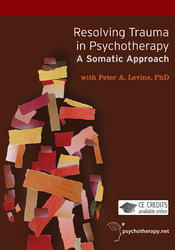 Mental and physical wellness are interwoven. As such, there is a need for evidence-based, body-oriented approaches to treating mental health issues such as trauma. Through the intensive study of the psychobiology of trauma, Dr. Peter Levine has developed a body-oriented approach called Somatic Experiencing (SE) as a framework for assessing and treating trauma. In this video (running 3 hours and 20 minutes), Levine provides a basic introduction to the conceptual framework and clinical tools used in SE.
Mental and physical wellness are interwoven. As such, there is a need for evidence-based, body-oriented approaches to treating mental health issues such as trauma. Through the intensive study of the psychobiology of trauma, Dr. Peter Levine has developed a body-oriented approach called Somatic Experiencing (SE) as a framework for assessing and treating trauma. In this video (running 3 hours and 20 minutes), Levine provides a basic introduction to the conceptual framework and clinical tools used in SE.
Levine uses a variety of instructional approaches to help viewers gain a basic understanding of the role of the body and body-oriented interventions in addressing trauma. At several points in the film Levine is joined by Laura Regalbuto, who interviews him by posing questions such as, “What is trauma and what happens to the nervous system of a person who experiences trauma?” Levine clearly articulates the conceptual foundation for SE, including a description of Dr. Stephen Porge’s polyvagal theory. Levine also describes the nine building blocks of SE. Throughout the video, segments from the case of Ray, a progression of five SE sessions facilitated by Levine, are presented to illustrate these concepts and demonstrate how positive change can occur through the application of SE.
Central to the SE approach is the assertion that trauma occurs when we are overwhelmed by an experience, or experiences, such that we are unable to physiologically and psychologically process the event(s). This state of being overwhelmed is thought to result in an inability to restore our equilibrium due to the sustained physiological responses associated with the stress response system. Levine argues that these physiological responses must be addressed in order for traditional cognitive, behavioral and affective approaches to be effective. Thus, he developed SE to do just that.
Though Levine asserts that SE can be used to address a host of traumatic experiences including accidents, abuse, medical issues, sexual assault and natural disasters, the primary focus of the video is on a war-related trauma as presented through the case of Ray. Ray experienced trauma when he was involved in an explosion during military deployment. Several months after the trauma, in addition to symptoms associated with traumatic brain injury and post-traumatic stress disorder (PTSD), Ray exhibited medically unexplained physical spasms resembling symptoms of Tourette syndrome. Over the course of five sessions, Levine uses SE techniques to help Ray build body awareness, learn to access the relaxation response, and begin to process his affective experiences. Ray reports decreases in PTSD symptoms as well as a reduction in physical spasms. Viewing the progression of Ray’s treatment with Levine’s accompanying commentary clearly illustrates how SE is used to address Ray’s concerns.
Consequently, the potential benefits of viewing this video for counseling professionals who treat trauma are several-fold. Broadly speaking, in order to effectively help clients heal from trauma, it is critical that counselors understand the psychobiology of trauma and have the clinical tools to address both mind and body. Viewing this video is a step toward this end. The case presented is a powerful demonstration of SE. Of course, further training and exposure to a variety of cases is necessary in order to truly understand SE and how it can be applied to treat other types of trauma and symptomology.
Like many introductory videos, for most counselors (particularly those who have limited previous knowledge of body-oriented approaches) this video will likely raise more questions than answers. In fact, there are several points in the video where Levine cautions that further training is needed to utilize the interventions that he demonstrates. For instance, Levine frequently uses physical touch as an intervention. At minimum, to utilize these touch-based approaches ethically and effectively, counseling professionals must complete advanced training in bodywork and clearly address the use of physical touch in the informed consent process.
Viewing this video will give counselors a basic understanding of SE. For those interested in integrating SE into their practice, the complete SE training is over 200 contact hours and is typically completed through a series of eight trainings over the course of 3 years. Further information is available at http://www.traumahealing.org.
Reviewed by: Jamie E. Crockett, NCC, Wake Forest University
Psychotherapy.net (Producer), & Yalom, M.-H. (Director). (2015). Resolving trauma in psychotherapy: A somatic approach with Peter A. Levine, Ph.D. [Streaming video]. Retrieved from www.psychotherapy.net
Available in streaming format and as part of video subscription at www.psychotherapy.net/subscriptions.
The Professional Counselor
http://tpcjournal.nbcc.org
 In the African American community, there is a theme of pain and hurt that is often hidden behind family secrets. These family secrets are deeply rooted in the African American experience of slavery and racism that is carried throughout generations. In her 35-minute interview with Monica McGoldrick, MA, LCSW, PhD (honorary), Elaine Pinderhughes, MSW, provides a comprehensive and in-depth narrative about her family heritage, supported by 30 years of research on her family’s genealogy. After the death of her father in 1976 and inspired by Alex Haley’s book entitled Roots, Pinderhughes set out to explore her own family’s roots. This video provides viewers with a glimpse into Pinderhughes’s family’s history, their secrets, and the truth that she discovered.
In the African American community, there is a theme of pain and hurt that is often hidden behind family secrets. These family secrets are deeply rooted in the African American experience of slavery and racism that is carried throughout generations. In her 35-minute interview with Monica McGoldrick, MA, LCSW, PhD (honorary), Elaine Pinderhughes, MSW, provides a comprehensive and in-depth narrative about her family heritage, supported by 30 years of research on her family’s genealogy. After the death of her father in 1976 and inspired by Alex Haley’s book entitled Roots, Pinderhughes set out to explore her own family’s roots. This video provides viewers with a glimpse into Pinderhughes’s family’s history, their secrets, and the truth that she discovered.




